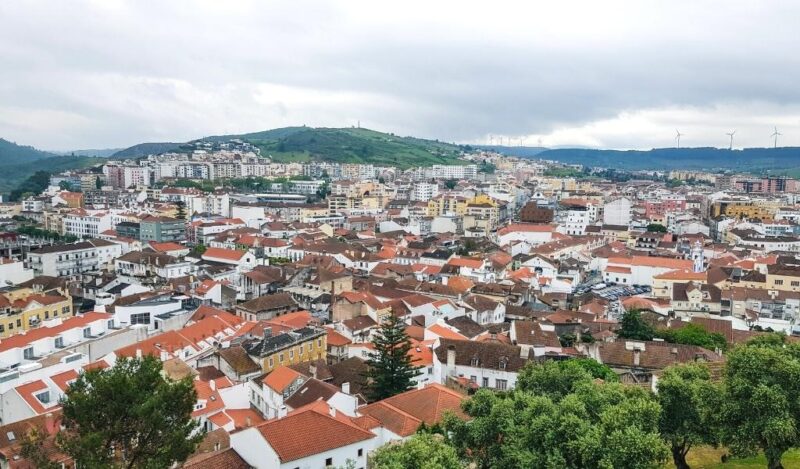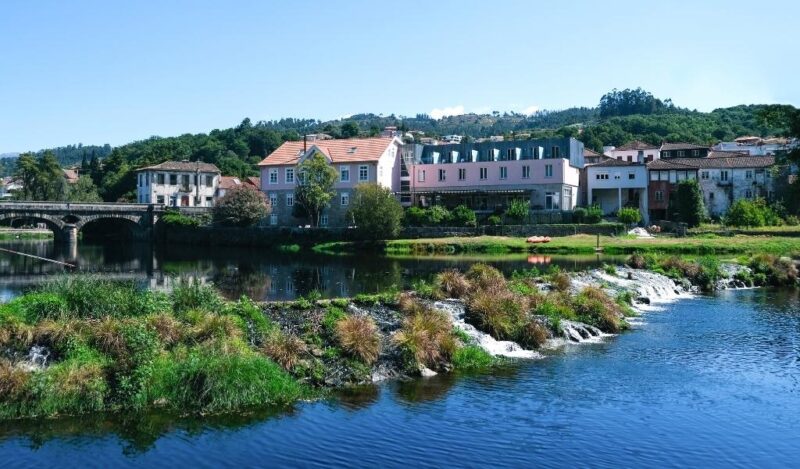Located in Celorico da Beira in the Guarda district, Linhares da Beira is one of the smallest and most isolated of the “12 Historical Villages of Portugal” (a program created by the Portuguese government in 1991, to restore and enhance a series of villages in the Beira Interior region, older than the country itself).
However, the history of Linhares da Beira impresses any traveler! First, because there are records of the occupation of pre-Roman, Roman, Visigoth, and Muslim peoples in this same place, and then because the village itself was founded in the 12th century, at the same time that Portugal became a country!
So, do you want to know more about 1 Day In Linhares Da Beira: The Perfect Linhares Da Beira Itinerary? Keep reading!
This post may contain affiliate links, meaning I earn a small commission if you make a purchase, at no additional cost to you. Please read my disclosure & privacy policy for more information.
No time to read now? Pin it for later!


Brief History of Linhares da Beira
The village of Linhares da Beira (or simply Linhares) was founded in the 12th century by Afonso Henriques, the first king of Portugal. Nevertheless, it’s known that the place had already been inhabited by pre-Roman, Roman, Visigoth, and Muslim peoples before it passed to Portuguese rule with the Christian Reconquista.
After Portugal established its definitive borders, this medieval village became part of the defensive line of Mondego Valley. And during the reign of King Dinis, the imposing Castle of Linhares da Beira was built, serving as a strategic fortress until the 17th century.

The vast majority of constructions in Linhares da Beira date back to the Middle Ages, more precisely to the period between the 12th and 14th centuries. Even so, the small village saw an important architectural reform in the reign of King Manuel I, with the incorporation of many Manueline details in its buildings.
Visiting Linhares da Beira
As I mentioned in the introduction, Linhares da Beira is one of the most isolated and remote historical villages of all. This is because it’s located about 60 km from the Serra da Estrela, the highest mountain range in mainland Portugal. So you must be very careful (and patient) with the road!
Honestly, some of the 12 Historical Villages of Portugal can be visited in one morning or afternoon, as is the case of Castelo Mendo, Idanha-a-Velha, Linhares da Beira, Marialva, Piódão, or Sortelha. As for the others, it depends on the number of monuments you want to include in your itinerary.
Since Almeida, Belmonte, Castelo Novo, Castelo Rodrigo, and Monsanto are towns, it’s likely that you’ll need a day (or two) to explore them from one end to the other. And the same happens with Trancoso, which is a city. By the way, here’s the list of the 12 Historical Villages of Portugal:
- Almeida, in the Guarda district
- Belmonte, in the Castelo Branco district
- Castelo Mendo, in the Guarda district
- Castelo Novo, in the Castelo Branco district
- Castelo Rodrigo, in the Guarda district
- Idanha-a-Velha, in the Castelo Branco district
- Linhares da Beira (or simply Linhares), in the Guarda district
- Marialva, in the Guarda district
- Monsanto, in the Castelo Branco district
- Piódão, in the Coimbra district
- Sortelha, in the Guarda district
- Trancoso, in the Guarda district
Linhares da Beira Itinerary
Misericórdia Church
The Misericórdia Church (formerly known as Saint Isidore Church) has served as the headquarters of the Misericórdia of Linhares da Beira since the foundation of this solidarity institution in 1576. But it’s thought that the Catholic temple was built in the late 13th century or early 14th century.

For this reason, its architectural origins are Romanesque, as evidenced by some external structural elements. Even so, its current appearance is the result of a profound intervention in 1622, highlighting from this time the 16th-century paintings that decorate its interior.
Barbosa Fountain
The Barbosa Fountain is what is usually called a “fonte de chafurdo” or “fonte de mergulho” (ie, a “drinking fountain). These types of community fountains are basically shallow pits, protected by a vaulted stone structure.
The “fontes de chafurdo” (or “de mergulho”) are mostly built below ground, with stairs to access them. The water, on the other hand, was collected using clay pots and pitchers.
The Barbosa Fountain was closed for reasons of sanitary hygiene – in fact, as happened with most of these fountains. And, despite its small size, it’s curious to see that it still bears the coat of arms of the old town of Linhares da Beira!

Corte Real Manor
The Corte Real Manor is one of the noble manor houses that you still find today in Linhares da Beira. Constructed in the second half of the 18th century, this sumptuous building stands out among the modest structures of the lower part of the historical village.

Unfortunately, in the 1940s, the manor was left in ruins after a cyclone hit. But, in 2002, the Municipality of Celorico da Beira decided to proceed with its restoration and converted it into a hotel: the INATEL Linhares da Beira Hotel Rural ***.
Pillory

The Pillory of Linhares da Beira dates from the reign of King Manuel I, as can be seen from the presence of a cross and an armillary sphere on its capital – two typically Manueline symbols.
Nowadays, it’s known that this Pillory was built in 1510 after the old town received a new charter from King Manuel.
Like the pillories of other historical villages (such as Belmonte and Idanha-a-Velha), this structure is made of stone and has three steps.
But, interestingly, the first step is twice the height of the others!
Forum & Mergulho Fountain
The Linhares da Beira Forum is, without a doubt, the monument that best demonstrates the importance and autonomy that the historical village had in the past. Well, in this small granite assembly, the so-called “good men of the municipality” gathered to decide administrative and judicial issues.


This meeting space – absolutely unique in Portugal – consists of a table and stone benches, and displays the coat of arms of Linhares da Beira. In addition, it’s based on another Mergulho Fountain, with the same characteristics as the Barbosa Fountain.
House of the Jew
The House of the Jew is a very different building from the rest for two reasons: first, because of the magnificent Manueline window, the prettiest in the village (in my opinion); and then due to the passage that crosses its entire ground floor.
This residence was known as House of the Jew as it’s suspected that the former Medieval Jewish Quarter of Linhares da Beira was located here.
The large arch that gives access to the Travessa do Passadiço was first built in the Gothic style but gained new architectural contours in the Manueline period.

Pina Aragão Manor

Another imposing manor house in Linhares da Beira is the Pina Aragão Manor. However, unlike the Corte Real Manor, this manor was built in the 16th century and in the upper part of the historical village, a few meters from the Castle.
On the main façade of this two-story noble residence, you can see the family’s coat of arms made in stone. In fact, the Pina Aragão family was very influential in this region – as was common at that time and in small villages.
For example, Luís de Pina Aragão lived in the 18th century and was superintendent of the Coudelarias da Guarda (ie, the regional stud houses). And in the 19th century, João de Pina Aragão made a career as a doctor.
Castle of Linhares da Beira
Last but not least, the jewel of Linhares da Beira: the Castle! As I mentioned earlier, this medieval fortress was part of the defensive line of the region for several centuries, thanks to its construction on rocky terrain and at an altitude of 800 meters – which gave it a decisive strategic advantage.

Although King Dinis was largely responsible for its construction at the end of the 13th century, it’s known that a primitive structure already existed in the time of King Sancho I – almost a century before. The existence of two towers (the Keep and the Clock Tower) is because the Castle had two walled precincts.
Map of the Linhares da Beira Itinerary
Share this blog post on your social media!
More Posts about Portugal
4 Best Monasteries In Portugal (That You Should Visit This Year)
5 Best Palaces In Sintra (That You Should Visit This Year)
1 Day In Penafiel: The Perfect Penafiel Itinerary
More Posts about Travel Itineraries
1 Day In Penafiel: The Perfect Penafiel Itinerary
1 Day In Torres Vedras: The Perfect Torres Vedras Itinerary
2 Days In Arcos De Valdevez: The Perfect Arcos De Valdevez Itinerary
What Photography Gear Do I Use?
- Camera Body: Fujifilm X-T4 Mirrorless
- Camera Lens: Fujinon XF 18-55 mm F2.8-4 R LM OIS
- Tripod: Manfrotto Compact Action
- Small Tripod: Manfrotto PIXI Mini
- Smartphone Adaptor: Manfrotto PIXI Clamp
- Memory Card: SanDisk 128GB Extreme PRO SDXC





